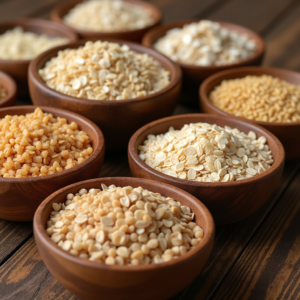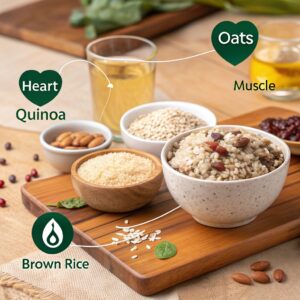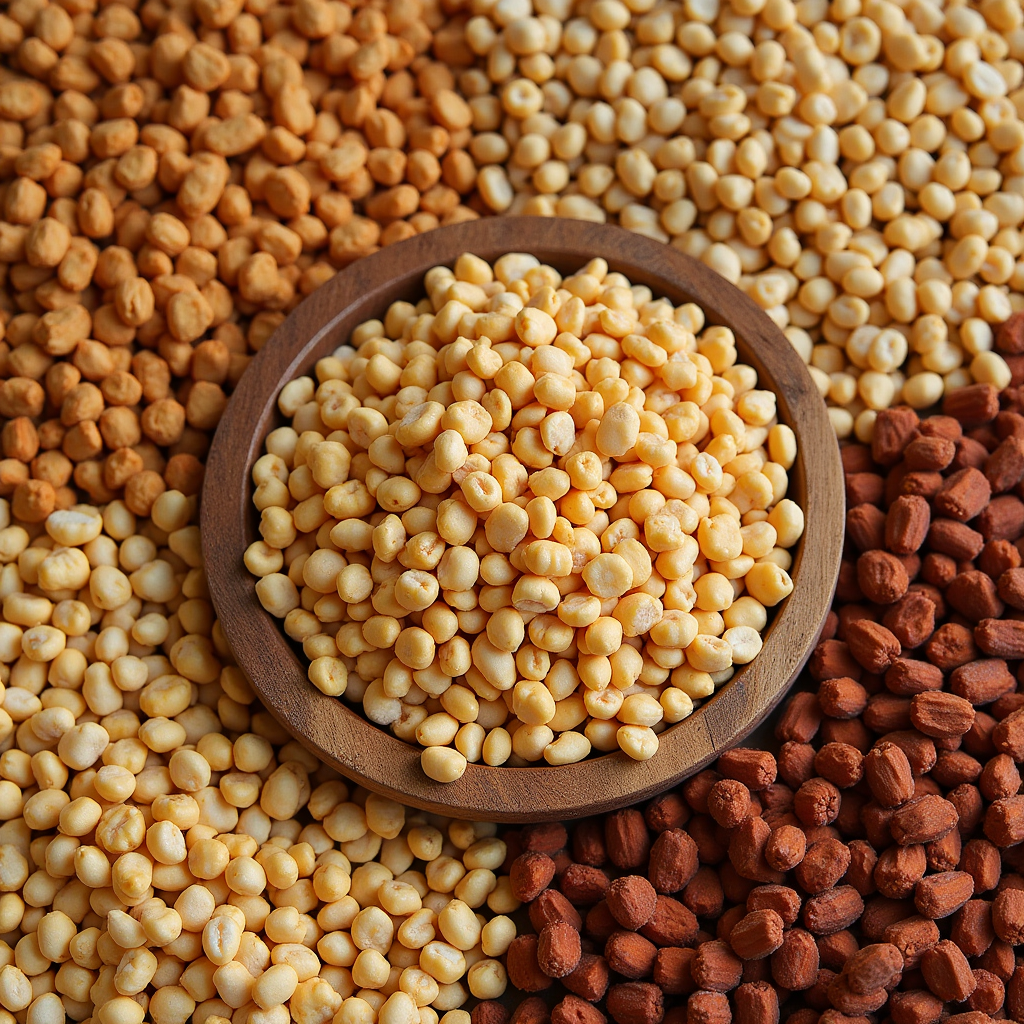Table of Contents
ToggleOutline
| Heading | Subtopics Covered |
|---|---|
| Amazing Grains: Health Benefits, Types, and How to Use Them | Introduction to grains and their importance in a healthy diet |
| Introduction | What are grains? Why are they called “amazing”? |
| The Nutritional Power of Grains | Overview of the nutrients found in grains (fiber, protein, vitamins, minerals) |
| Whole Grains vs. Refined Grains | Key differences and why whole grains are healthier |
| Top Nutrients in Grains | Fiber, protein, B vitamins, iron, magnesium |
| Types of Amazing Grains and Their Benefits | A deep dive into different grain varieties |
| Common Whole Grains | Brown rice, quinoa, whole wheat, oats, barley |
| Ancient Grains with Superfood Status | Amaranth, farro, spelt, millet, teff |
| Gluten-Free Grains | Buckwheat, sorghum, corn, rice |
| Grains and Their Health Benefits | Heart health, digestion, weight management, diabetes prevention |
| How to Incorporate Grains into Your Diet | Best ways to cook and consume grains daily |
| Cooking Methods for Different Grains | Boiling, steaming, sprouting, fermenting |
| Delicious and Nutritious Grain-Based Meals | Breakfast, lunch, dinner, snacks using grains |
| Grains for Special Diets | Vegan, gluten-free, high-protein diets |
| Frequently Asked Questions (FAQs) | Common questions and answers about grains |
| Conclusion | Final thoughts on the importance of including grains in your diet |
Introduction
Grains have been a dietary staple for thousands of years, providing essential nutrients and energy to civilizations worldwide. But not all grains are created equal—some are packed with fiber, protein, and powerful antioxidants, making them truly amazing for your health. Whether you’re looking to improve digestion, manage weight, or simply eat healthier, incorporating the right grains into your diet can be a game-changer.
Why Are Grains Called “Amazing”?
Grains are often referred to as “amazing” because they:
Provide Essential Nutrients – They are rich in fiber, protein, vitamins, and minerals.
Support Heart Health – Whole grains help lower cholesterol and blood pressure.
Aid Digestion – High-fiber grains promote gut health and prevent constipation.
Boost Energy – Complex carbohydrates provide long-lasting fuel for the body.
Help Manage Weight – Grains keep you full longer, reducing overeating.
With so many health benefits, it’s no wonder that grains are a key component of balanced, nutritious diets worldwide.
What to Expect in This Article
In the next sections, we’ll cover:
The difference between whole and refined grains
Nutritional powerhouses found in grains
The best types of grains and their health benefits
How to cook and incorporate grains into your meals
Answers to common questions about grains
Are you ready to unlock the power of amazing grains? Let’s dive in!
The Nutritional Power of Grains
Grains are often praised for their rich nutritional profile, providing essential vitamins, minerals, fiber, and protein that contribute to overall health. However, not all grains are equal whole grains pack the most nutrients, while refined grains lose many benefits during processing.
Whole Grains vs. Refined Grains
Before diving into the nutrients found in grains, it’s important to understand the difference between whole grains and refined grains:
| Type of Grain | Definition | Nutritional Value |
|---|---|---|
| Whole Grains | Contain all three parts of the grain: the bran, germ, and endosperm | High in fiber, vitamins, minerals, and antioxidants |
| Refined Grains | The bran and germ are removed, leaving only the endosperm | Lower in fiber and nutrients, higher in simple carbohydrates |
Why Choose Whole Grains?
Whole grains provide slow-releasing energy, help maintain stable blood sugar levels, and keep you fuller for longer. In contrast, refined grains digest quickly, leading to blood sugar spikes and crashes.
Top Nutrients Found in Grains
Grains contain a variety of essential nutrients, making them an important part of a balanced diet. Here are some of the key nutrients found in whole grains:
1. Dietary Fiber
One of the biggest advantages of whole grains is their high fiber content, which:
Aids digestion and prevents constipation Lower
s cholesterol and supports heart health
Helps control blood sugar levels
Promotes satiety and weight management
Best fiber-rich grains: Oats, barley, quinoa, whole wheat, brown rice
2. Plant-Based Protein
Grains are an excellent source of plant-based protein, which is essential for:
Muscle growth and repair
Boosting metabolism
Supporting immune function
High-protein grains: Quinoa, amaranth, farro, teff, millet
3. B Vitamins (B1, B2, B3, B6, Folate)
B vitamins play a crucial role in energy production, brain function, and red blood cell formation. Whole grains are particularly rich in:
Thiamine (B1): Helps convert food into energy
Niacin (B3): Supports skin health and nervous system function
Folate (B9): Essential for cell growth and fetal development
B-vitamin-rich grains: Whole wheat, brown rice, oats, millet, quinoa
4. Minerals: Iron, Magnesium, Zinc
Whole grains contain essential minerals that contribute to overall well-being:
Iron: Prevents anemia and improves oxygen transport in the blood
Magnesium: Supports bone health and muscle function
Zinc: Strengthens the immune system and aids in wound healing
Mineral-rich grains: Quinoa, teff, amaranth, buckwheat, barley

How Do Grains Benefit Your Health?
The combination of fiber, protein, and essential nutrients makes grains a powerhouse food. Here’s how they contribute to better health:
Support Heart Health – Fiber and antioxidants help lower cholesterol and reduce the risk of heart disease.
Aid in Weight Management – Whole grains keep you fuller longer, reducing overeating.
Improve Digestion – High-fiber grains promote gut health and prevent constipation.
Regulate Blood Sugar – Whole grains prevent blood sugar spikes and crashes, reducing the risk of type 2 diabetes.
Boost Energy Levels – B vitamins and complex carbs provide steady energy throughout the day.
Up Next: “Types of Amazing Grains and Their Benefits”
In the next section, we’ll explore different types of grains, including ancient grains, gluten-free options, and common whole grains, along with their unique health benefits.
Types of Amazing Grains and Their Benefits
Grains come in a wide variety, each offering unique nutrients, flavors, and health benefits. Some grains have been dietary staples for centuries, while others are considered “ancient grains” with superior nutritional value. In this section, we’ll explore different types of whole grains, ancient grains, and gluten-free options, highlighting their health benefits.
Common Whole Grains and Their Benefits
Whole grains retain all three parts of the grain—bran, germ, and endosperm—making them rich in fiber, vitamins, and minerals. Here are some of the most popular and nutritious whole grains:
1. Brown Rice
Brown rice is a healthier alternative to white rice because it retains its fiber and nutrients.
Benefits:
High in fiber, aiding digestion and weight management
Rich in manganese for bone health and metabolism
Naturally gluten-free
How to use: Great in stir-fries, grain bowls, and as a side dish
2. Quinoa
Quinoa is considered a super grain because it’s one of the few plant foods that contain all nine essential amino acids, making it a complete protein.
Benefits:
High in protein and fiber
Rich in iron, magnesium, and antioxidants
Naturally gluten-free
How to use: Perfect in salads, soups, or as a rice substitute
3. Oats
Oats are well known for their heart-healthy properties, thanks to their high beta-glucan fiber content.
Benefits:
Helps lower cholesterol and regulate blood sugar
Keeps you full for longer, reducing cravings
Supports digestive health
How to use: Ideal for oatmeal, granola, or smoothies
4. Whole Wheat
Whole wheat is a staple grain that provides a rich source of fiber and B vitamins.
Benefits:
Supports digestion and gut health
Helps maintain energy levels with complex carbohydrates
Contains antioxidants that support heart health
How to use: Found in whole wheat bread, pasta, and baked goods
5. Barley
Barley is an underrated grain packed with fiber and essential nutrients.
Benefits:
High in soluble fiber, which helps lower cholesterol
Supports gut health and digestion
Provides long-lasting energy
How to use: Great for soups, stews, and grain salads
Ancient Grains with Superfood Status
Ancient grains have been cultivated for thousands of years and remain largely unchanged, making them highly nutrient-dense.
6. Amaranth
Amaranth is a tiny but powerful grain loaded with protein and micronutrients.
Benefits:
High in iron, supporting oxygen transport in the blood
Contains lysine, an amino acid that promotes muscle growth
Naturally gluten-free
How to use: Use in porridge, soups, or baked goods
7. Farro
Farro is a hearty, chewy grain packed with fiber and protein.
Benefits:
High in antioxidants, helping to fight inflammation
Supports weight management with slow-digesting carbs
Rich in magnesium, improving muscle and nerve function
How to use: Use in salads, grain bowls, and risottos
8. Spelt
Spelt is an ancient wheat variety with higher protein content than modern wheat.
Benefits:
Easier to digest than conventional wheat
Supports heart health with fiber and antioxidants
Provides a rich source of B vitamins
How to use: Found in bread, pasta, and baked goods
9. Teff
Teff is a tiny Ethiopian grain known for its high calcium and iron content.
Benefits:
Boosts bone health with calcium
Provides sustained energy with complex carbohydrates
Naturally gluten-free
How to use: Used in porridges, bread, or as a side dish
Gluten-Free Grains for Sensitive Diets
For those with gluten intolerance or celiac disease, there are plenty of nutrient-rich gluten-free grain options:
10. Buckwheat
Despite its name, buckwheat is not related to wheat and is naturally gluten-free.
Benefits:
High in fiber and antioxidants
Supports heart health by reducing blood pressure
Helps regulate blood sugar levels
How to use: Used in pancakes, noodles, and porridge
11. Sorghum
Sorghum is a mild-tasting, gluten-free grain that is often used as a flour alternative.
Benefits:
Packed with antioxidants for immune support
High in fiber, aiding digestion
Naturally gluten-free
How to use: Used in baking, cereals, and gluten-free beer
12. Corn (Maize)
Corn is one of the most widely consumed grains worldwide, offering a good source of fiber and antioxidants.
Benefits:
High in lutein, promoting eye health
Provides slow-digesting carbs for steady energy
Naturally gluten-free
How to use: Found in tortillas, polenta, and cornmeal-based dishes
Health Benefits of Including Grains in Your Diet
Regardless of the type, incorporating grains into your diet provides a variety of health benefits:
Heart Health: Whole grains help lower cholesterol and reduce the risk of heart disease.
Better Digestion: High-fiber grains promote gut health and prevent constipation.
Weight Management: Whole grains keep you full longer, reducing hunger cravings.
Stable Blood Sugar: Whole grains help regulate glucose levels, reducing diabetes risk.
Nutrient Boost: Grains provide essential vitamins and minerals for overall well-being.

Up Next: “How to Incorporate Grains into Your Diet”
Now that we’ve explored the best grains and their benefits, the next section will cover how to cook them, delicious recipes, and the best ways to add grains to your daily meals.
How to Incorporate Grains into Your Diet
Now that we’ve explored the different types of amazing grains and their benefits, let’s talk about the best ways to cook and enjoy them. Grains can be a delicious and versatile part of your meals, whether you’re looking for breakfast options, hearty lunches, or nutritious dinners.
Cooking Methods for Different Grains
Each type of grain requires a specific cooking method to bring out its best texture and flavor. Here’s a quick guide on how to cook some of the most popular grains:
| Grain | Cooking Method | Water-to-Grain Ratio | Cooking Time |
|---|---|---|---|
| Brown Rice | Boil, simmer | 2:1 | 40–45 minutes |
| Quinoa | Boil, simmer | 2:1 | 15 minutes |
| Oats | Boil | 2:1 | 5 minutes (quick oats) / 30 minutes (steel-cut) |
| Barley | Boil, simmer | 3:1 | 45–60 minutes |
| Farro | Boil, simmer | 2.5:1 | 25–30 minutes |
| Buckwheat | Boil | 2:1 | 20 minutes |
| Millet | Boil, steam | 2:1 | 20 minutes |
| Amaranth | Boil, simmer | 3:1 | 20 minutes |
| Sorghum | Boil, simmer | 4:1 | 50–60 minutes |
Delicious and Nutritious Grain-Based Meals
Grains can be used in a variety of dishes throughout the day. Here are some easy ways to add more grains to your diet:
Breakfast Ideas
Oatmeal with Berries and Nuts – A heart-healthy start to your day
Whole Wheat Toast with Avocado – Packed with fiber and healthy fats
Buckwheat Pancakes – A gluten-free alternative with a nutty taste
Quinoa Breakfast Bowl – Quinoa mixed with almond milk, bananas, and cinnamon
Lunch & Dinner Ideas
Quinoa Salad with Chickpeas and Vegetables – A high-protein, plant-based meal
Brown Rice Stir-Fry with Tofu and Vegetables – A fiber-rich, satisfying dish
Farro and Roasted Vegetable Bowl – A nutrient-packed, Mediterranean-inspired meal
Barley and Lentil Soup – A warm, hearty soup filled with fiber and protein
Snack & Side Dish Ideas
Air-Popped Popcorn – A whole grain, low-calorie snack
Corn Tortillas with Salsa and Beans – A delicious gluten-free option
Whole Wheat Crackers with Hummus – A crunchy, protein-rich snack
Grains for Special Diets
No matter your dietary preference, grains can fit into your meal plan:
Gluten-Free Diet – Opt for quinoa, rice, millet, sorghum, or buckwheat
High-Protein Diet – Try quinoa, amaranth, teff, and farro
Vegan Diet – Use oats, barley, brown rice, and whole wheat in plant-based meals
Low-Carb Diet – Reduce grain intake, but opt for fiber-rich whole grains in moderation
Frequently Asked Questions (FAQs)
1. What are the healthiest grains to eat?
The healthiest grains are quinoa, oats, brown rice, barley, and farro because they are rich in fiber, protein, and essential vitamins.
2. Are grains bad for weight loss?
No! Whole grains help with weight loss by keeping you full longer and preventing overeating. Just avoid refined grains like white rice and white bread.
3. Which grains are best for digestion?
Grains high in fiber, like oats, barley, and quinoa, help improve digestion and gut health.
4. Can people with gluten intolerance eat grains?
Yes! Gluten-free grains like quinoa, buckwheat, millet, and rice are safe for people with gluten intolerance or celiac disease.
5. How much grain should I eat per day?
The recommended intake varies, but on average, adults should consume 3–6 servings of grains daily, with at least half coming from whole grains.
6. What is the best grain for diabetics?
Grains with a low glycemic index like quinoa, barley, oats, and brown rice help manage blood sugar levels.
Conclusion
Grains are one of the most nutritious and versatile foods available. They provide essential fiber, protein, vitamins, and minerals, supporting heart health, digestion, weight management, and overall well-being. Whether you choose ancient grains like quinoa and farro, gluten-free grains like millet and sorghum, or staples like brown rice and oats, incorporating them into your diet can transform your health.
By choosing whole grains over refined grains, cooking them with simple methods, and adding them to your meals, you can enjoy the full benefits of amazing grains every day

